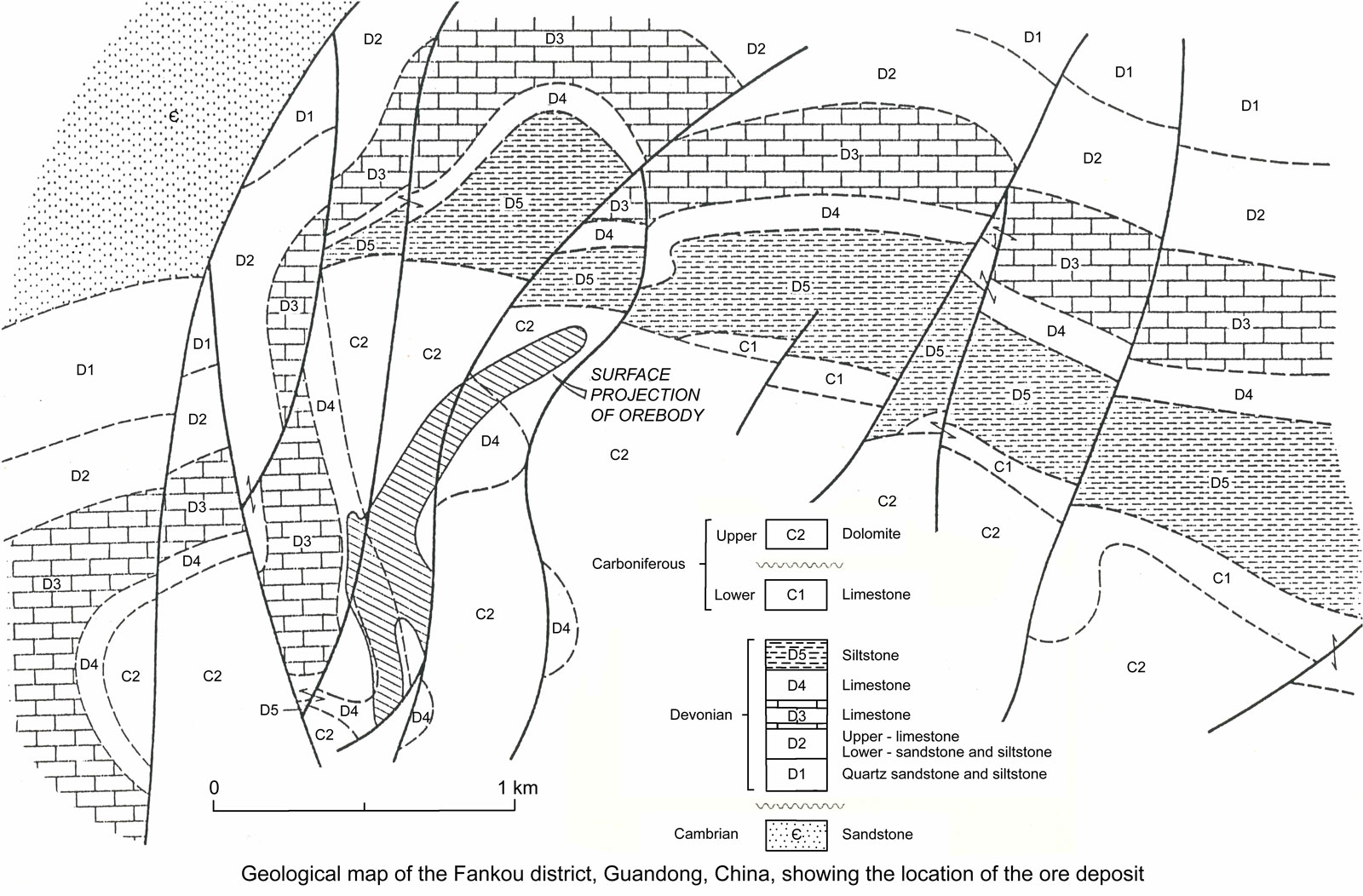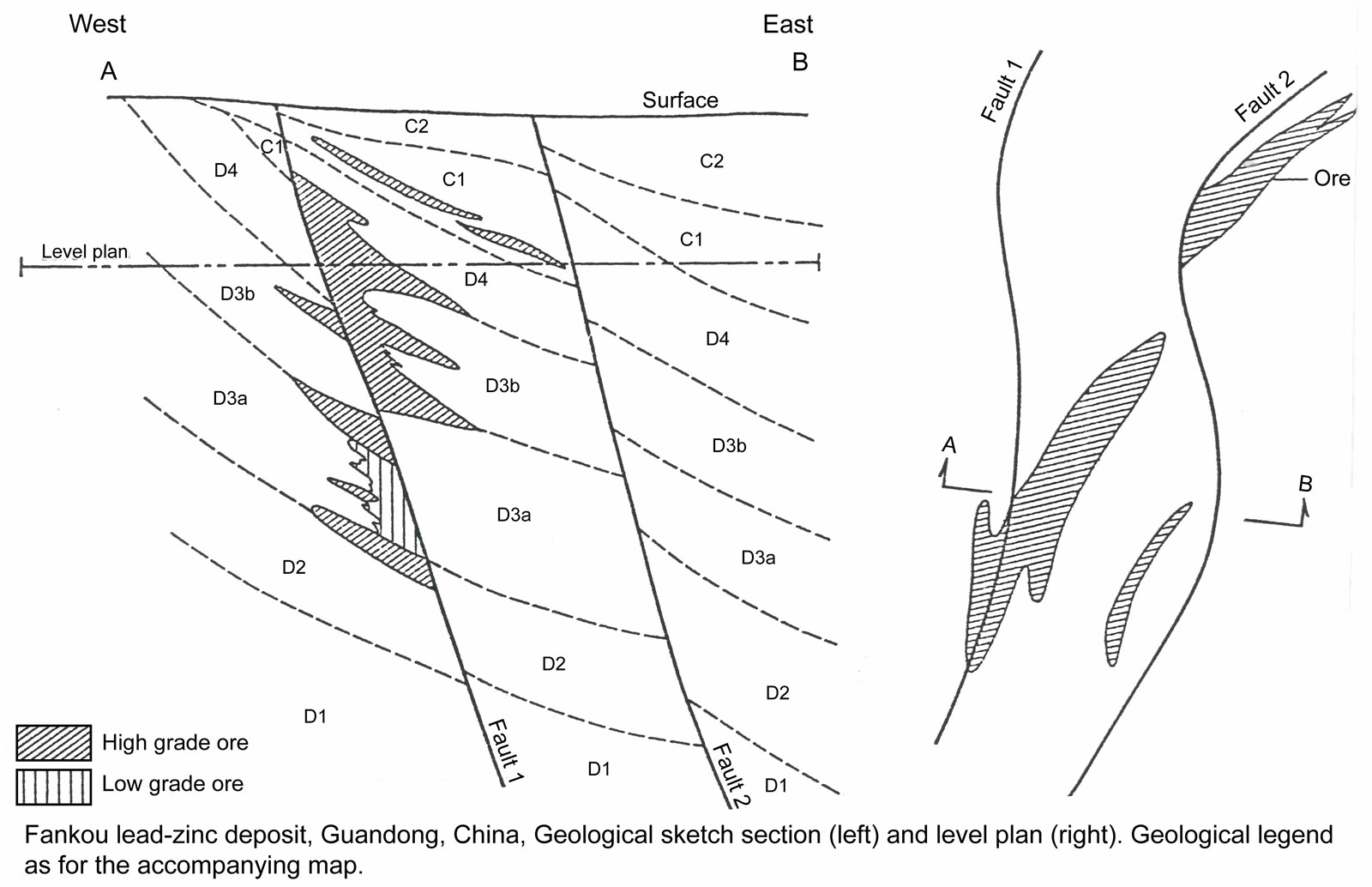|
Fankou |
|
|
Guangdong, China |
| Main commodities:
Zn Pb Ag
|
|
 |
|
 |
 |
Super Porphyry Cu and Au


|
IOCG Deposits - 70 papers

|
All papers now Open Access.
Available as Full Text for direct download or on request. |
|
 |
The Fankou stratabound carbonate hosted zinc, lead, silver deposit is located 60 km east of the city of Shaoguan, some 200 km north of Guangzhou in northern Guandong province, south-eastern China.
The Fankou deposit is hosted by Middle Palaeozoic carbonates deposited within the Devonian to Permian Qu-Ren Depression of the South China Paraplatform. In the mine area the stratigraphic sequence comprises, from the top:
Permian
Upper - shale at the base of a coal-bearing formation;
Lower - a thin limestone unit;
Upper Carboniferous
Unit C2 - comprising ~400 m of dolostone and limestone;
Unconformity
Lower Carboniferous
Unit C1 - which is 10 to 17 m thick, consisting of grey limestone, dark claystone and silt-shale;
Devonian
Upper Devonian
Unit D5 - siltstone, which is 140 to 110 m thick, but lenses out towards the orebody in the west. In the ore zone, unit D4 is conformable with the overlying unit C1, while to the east, unit D5 separates the two;
Unit D4 - Mao-Zi-Feng Formation - sandstone, silt-shale, and dolostone;
Middle Devonian
Unit D3- Tian-Zi-Ling Formation - that is composed of three sections: i). a lower section of ~90 to 115 m of dark oolitic limestone, bioclastic limestone, and thin marlstone; ii). a middle section of 110 to 150 m of black, carbonaceous limestone; and iii). an upper section of ~50 to 105 m of spotted-textured limestone;
Unit D2 - Dong-Gang-Ling Formation - a lower, mainly of dark silt-shale and siltstone, that is ~50 m thick, over lain by an upper dark limestone and algae-limestone sub-unit;
Unit D1 - Gui-Tou Formation - which from the base, consist of conglomerate stone, quartz sandstone, siltstone
and red shale, with a thickness of ~120 to 310 m;
Unconformity
Cambrian
Ba-Cun Formation - low grade metamorphic sandstones and shales with a total thickness of >1500 m;
Unconformity
Basement rocks of the basin are low grade metamorphic Proterozoic clastic rocks.
The sequence, from the base of unit D1 to the top of unit C1 is 600 m thick. The host limestones are dark grey in colour and are generally massive. Dips are generally from 30 to 60°, and the sequence is cut by a number of faults with displacements of only a few tens of metres. Three groups of faults have been recognised: NE, NNE and NNW trending sets. The NE faults were active before the Late Carboniferous and are interpreted to be syn-sedimentary structures. NNW faults were formed following the NE faults. The most recent are the NNE set, formed in Cenozoic time.
The principal host unit is the Middle Devonian Dong-Gang-Ling Formation (Lin Shaobiao, 1998), which consists mainly of limestone with a relatively high organic content, marine fossils and rich algae development.
The deposit is a carbonate hosted massive to semi-massive Pb/Zn/Ag sulphide deposits which has both stratabound and transgressive characteristics. There are five generally stratabound ore lenses developed adjacent to a steep composite fault zone, although not all individual ore positions can be correlated across the fault zone. Adjacent to this main central fault zone, these lenses thicken markedly and coalesce vertically in some cases, while they thin to 4 to 20 m, before pinching out 200 to 300m from the fault zone. They occur within a linear zone of some 1500 x 200 to 300 m, dip at from 30° to 60° and are developed over a stratigraphic interval of 400 m in sedimentary rocks deposited from the Mid-Devonian to Early Carboniferous, forming a 'christmas-tree' like body. The orebody is developed over a total vertical interval of 800 m within the mine area and was open at depth down plunge in 1980.
The ore occurs as fine grained and finely banded massive sulphides, comprising up to 70% sulphide, mainly pyrite, sphalerite and galena which account
for ~60% of all ore minerals, with the remainder including chalcopyrite, tetrahedrite, bournonite, arsenopyrite, antimonite, boulangerite and pyargyrite. There is a compositional banding (ranging from 1, up to 20 to 30 mm in thickness) of the major sulphides, with pyrite, in general forming finer bands, while the galena and sphalerite are in coarser bands, discontinuous lenses, blobs and cross-cutting veinlets, and in minor pale conformable carbonate bands within the ore.
In the vertical direction, pyrite is more abundant in the lower part of the mineralised zone than in the upper sections. Laterally, pyrite is more prevalent in
the wall rocks than within the Pb-Zn ore bodies. Pb-Zn minerals, pyrite and siderite, were deposited outward from the ore-body centre to the wall rocks on both sides, in the order: galena and sphalerite → pyrite → siderite. Fluid inclusion analyses indicate pyrite, Pb-Zn minerals (mainly galena and sphalerite), and siderite were enriched at different stages: pyrite first, followed by galena and sphalerite, and lastly siderite (Cao Jianjin, 1999).
Studies by Qiu and Wu (1999), have indicated palaeo-temperatures of sulphide formation as high as 200 to 350°C adjacent to and within the mineralised fault zones. Analyses of ore-forming inclusions indicated that temperatures in the wall rocks were 50 to 117°C, and reached 110 to 255°C in ore hosting rocks (Chen et al., 2000). Abundant amorphous organic matter with a relatively low reflectance occurs in pores and fractures within the ore zones and hosts. The character of the organic material varies with the Pb-Zn contents in different parts of the deposit and is interpreted to have been influenced by ore sulphide formation. Organic geochemical parameters suggest palaeo-temperatures in the wall rocks of <80°C which may have accompanied the formation of early sulphides, most likely pyrite deposited during synsedimentation or early diagenesis by bacterial sulphate reduction, rather than by thermochemical sulphate reduction. However, framboidal pyrite, generated during sedimentation by bacterial sulphate reduction, is virtually absent in ore samples and the rare framboidal Pb-Zn sulphides are regarded as evidence of replacement of early pyrite. The higher temperature sulphides emplaced near and within the faults are more likely to have formed by thermochemical sulphate reduction after sedimentation (Sun et al., 2009).
In 1980, the stated ore reserve was: 30 Mt @ 11% Zn, 5% Pb and 119 g/t Ag (Mine visit, 1980);
Fankou produced 60 000 t of Zn in 1982.


The most recent source geological information used to prepare this decription was dated: 2009.
Record last updated: 2/10/2021
This description is a summary from published sources, the chief of which are listed below.
© Copyright Porter GeoConsultancy Pty Ltd. Unauthorised copying, reproduction, storage or dissemination prohibited.
|
|
|
|
|
Dung, J., Yang, L., Chen, X., Wang, Q. and Liu, Y., 2005 - Fluid system and ore-forming dynamics of the Yuebei Basin, China: in Mao, J. and Bierlein, F.P., (Eds.), 2005 Mineral Deposit Research: Meeting the Global Challenge, Proceedings of the Eighth Biennial SGA Meeting Beijing, China, 18-21 August 2005, v.1, pp. 107-109.
|
Gu, L., Zaw, K., Hu, W., Zhang, K., Ni, P., He, J., Xu, Y., Lu, J. and Lin, C., 2007 - Distinctive features of Late Palaeozoic massive sulphide deposits in South China: in Ore Geology Reviews v.31, pp. 107-138.
|
Jiang, Y.-D., Qiu, H.-N. and Xu, Y.-G., 2012 - Hydrothermal fluids, argon isotopes and mineralization ages of the Fankou Pb-Zn deposit in south China: Insights from sphalerite 40Ar/39Ar progressive crushing: in Geochimica et Cosmochimica Acta v.84, pp. 369-379.
|
Sun, Y., Chane, J., Lu, J. and Liu, J., 2009 - Organically geochemical characteristics of the Fankou Pb-Zn deposit in North Guangdong Province, China: Implication for Pb-Zn enrichment: in Chinese Journal of Geochemistry, v.28, pp. 136-145.
|
|
Porter GeoConsultancy Pty Ltd (PorterGeo) provides access to this database at no charge. It is largely based on scientific papers and reports in the public domain, and was current when the sources consulted were published. While PorterGeo endeavour to ensure the information was accurate at the time of compilation and subsequent updating, PorterGeo, its employees and servants: i). do not warrant, or make any representation regarding the use, or results of the use of the information contained herein as to its correctness, accuracy, currency, or otherwise; and ii). expressly disclaim all liability or responsibility to any person using the information or conclusions contained herein.
|
Top | Search Again | PGC Home | Terms & Conditions
|
|